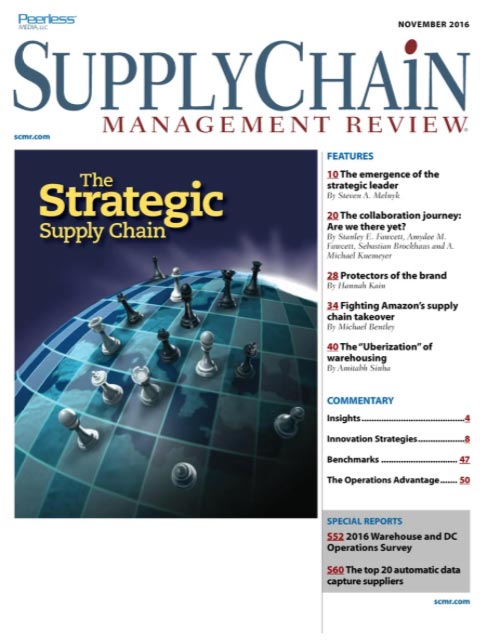Sorry, but your login has failed. Please recheck your login information and resubmit. If your subscription has expired, renew here.
November 2016
Is supply chain management strategic or tactical? Are the best supply chains collaborative? Should the goal be an integrated supply chain or an integrative supply chain? The answers are a mixed bag, according to this month’s contributors. Browse this issue archive.Need Help? Contact customer service 847-559-7581 More options
Supply chain management is a team endeavor, and developing an effective operational team is a challenge for any organization. But including innovation in the mix compounds that challenge. A study conducted last January by the MIT Supply Chain Strategy Lab sheds light on the dynamics of supply chain teams, and the factors that impact their performance. The study indicates that to successfully tackle innovation projects, a supply chain team should be composed of members with the knowledge, visibility, commitment and competence necessary to collaborate across multiple functional areas in the pursuit of shared objectives.
Simulation exercise
The sample for the study was a group of 112 master’s students from the MIT Global SCALE Network, an international alliance of supply chain education and research centers, which at the time had four centers in the United States, Europe, Asia and Latin America (the Network has since added two centers in China and Luxembourg). Over a period of three weeks that these students spent at MIT’s campus in Cambridge, Mass., they took part in a supply chain simulation known as The Fresh Connection. Students were grouped in teams of four members, chosen by a third party to maximize the diversity of centers represented in each team. The typical team was composed of students from four different centers who had never met each other.
The Fresh Connection simulation revolves around a fictitious company based in the Netherlands that manufactures and sells orange juice. At the beginning of the game the company is operating at a loss, and the mission of the team is to rescue it by making it profitable again. In the simulation, there are four functional positions in the company, focusing respectively on purchasing, operations, logistics and sales. Each function is helmed by a different student. Although they do have visibility into each other’s decisions, each one of these four positions controls only the decisions that correspond to their respective functions. Because there is no fifth position overseeing and coordinating the efforts of the previous four, the members have to find a way to work as a team—as opposed to operating as independent functions—in order to achieve the common goal of maximizing the company’s return on investment (ROI).
 |
This complete article is available to subscribers
only. Click on Log In Now at the top of this article for full access. Or, Start your PLUS+ subscription for instant access. |
SC
MR
Sorry, but your login has failed. Please recheck your login information and resubmit. If your subscription has expired, renew here.
November 2016
Is supply chain management strategic or tactical? Are the best supply chains collaborative? Should the goal be an integrated supply chain or an integrative supply chain? The answers are a mixed bag, according to this… Browse this issue archive. Access your online digital edition. Download a PDF file of the November 2016 issue. |
Download Article PDF |
Supply chain management is a team endeavor, and developing an effective operational team is a challenge for any organization. But including innovation in the mix compounds that challenge.
A study conducted last January by the MIT Supply Chain Strategy Lab sheds light on the dynamics of supply chain teams, and the factors that impact their performance. The study indicates that to successfully tackle innovation projects, a supply chain team should be composed of members with the knowledge, visibility, commitment and competence necessary to collaborate across multiple functional areas in the pursuit of shared objectives.
Simulation exercise
The sample for the study was a group of 112 master's students from the MIT Global SCALE Network, an international alliance of supply chain education and research centers, which at the time had four centers in the United States, Europe, Asia and Latin America (the Network has since added two centers in China and Luxembourg). Over a period of three weeks that these students spent at MIT's campus in Cambridge, Mass., they took part in a supply chain simulation known as The Fresh Connection. Students were grouped in teams of four members, chosen by a third party to maximize the diversity of centers represented in each team. The typical team was composed of students from four different centers who had never met each other.
The Fresh Connection simulation revolves around a fictitious company based in the Netherlands that manufactures and sells orange juice. At the beginning of the game the company is operating at a loss, and the mission of the team is to rescue it by making it profitable again. In the simulation, there are four functional positions in the company, focusing respectively on purchasing, operations, logistics and sales. Each function is helmed by a different student. Although they do have visibility into each other's decisions, each one of these four positions controls only the decisions that correspond to their respective functions. Because there is no fifth position overseeing and coordinating the efforts of the previous four, the members have to find a way to work as a team—as opposed to operating as independent functions—in order to achieve the common goal of maximizing the company's return on investment (ROI).
 |
SUBSCRIBERS: Click here to download PDF of the full article. |
SC
MR


Latest Supply Chain News
- How CPG brands can deliver on supplier diversity promises
- How S&OP provides the answer to in-demand products
- AI, virtual reality is bringing experiential learning into the modern age
- Humanoid robots’ place in an intralogistics smart robot strategy
- Tips for CIOs to overcome technology talent acquisition troubles
- More News
Latest Podcast

 Explore
Explore
Topics
Latest Supply Chain News
- How CPG brands can deliver on supplier diversity promises
- How S&OP provides the answer to in-demand products
- AI, virtual reality is bringing experiential learning into the modern age
- Humanoid robots’ place in an intralogistics smart robot strategy
- Tips for CIOs to overcome technology talent acquisition troubles
- There is still work to do to achieve supply chain stability
- More latest news
Latest Resources

Subscribe

Supply Chain Management Review delivers the best industry content.

Editors’ Picks





